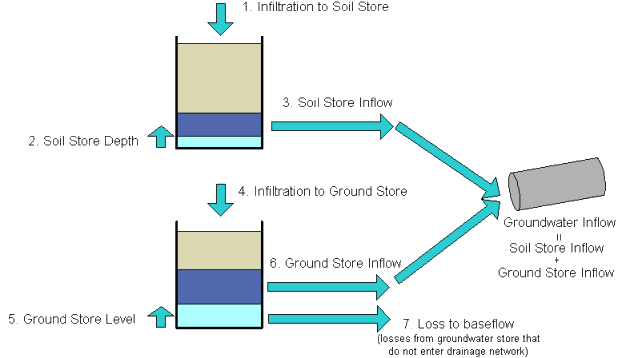Ground Infiltration Model
InfoWorks ICM models rainfall-induced infiltration and groundwater infiltration using a double reservoir model. The two reservoirs represent soil storage and ground storage. Dry weather infiltration and tidal infiltration are accounted for via their effect on the groundwater table. The infiltration model uses bulk mass balance equations and simplified flow equations to approximate the physical processes. Because the model is simplified it requires some degree of calibration.

Ground Water Infiltration Model
Rainfall runoff has three model components: initial loss (depression storage), runoff volume and runoff routing. Incident rainfall is initially stored in surface depressions, which are subject to evaporative loss (defined in the rainfall event). When rainfall exceeds depression storage in a given time step, a proportion of the excess rainfall goes to runoff according to the particular volume model used. The remaining rainfall is directed into the soil storage reservoir. When the soil reaches a given saturation threshold (the percolation threshold), water starts to percolate downwards. A proportion of this percolation flow (the percolation percentage infiltrating) infiltrates directly into the network while the remainder penetrates deeper to feed the groundwater storage reservoir. Note that the volume in the soil storage reservoir is also subject to evapotranspiration, though at a reduced rate.
When the groundwater storage reservoir reaches a particular threshold water loss due to baseflow occurs. When the groundwater level reaches a further infiltration threshold, groundwater infiltration occurs.
The infiltration model can be calibrated so that the ground water storage level relates to the actual groundwater table level. In this case, the infiltration threshold type and baseflow threshold types are set to levels that are relative to the chamber floor of the node that the particular subcatchment drains to. This is a reasonable estimate of the realistic level at which infiltration may occur.
In networks where infiltration is dominated by tidal influences, a time-varying profile for the groundwater storage level can be defined. This profile overrides the level calculated by the infiltration model and groundwater infiltration is then based on this level.
Equations
In InfoWorks ICM, incident rainfall is initially stored in surface depressions. The only loss from depression storage is evaporation. Once the surface depressions are full runoff occurs. This is when:
|
|
where: A is the surface area Sdepression is the depression depth |
The first assumption used in the model is that the rainfall that does not enter the network as runoff infiltrates into the soil store. If the soil store is full then the excess flow goes to runoff.
The continuity equation at the surface is:
|
|
where: Qrunoff is usually written Qrunoff =PR x Qrain PR is the percentage runoff for the surface Qsoil is the flow into the soil store, S |
The equations used to model the soil storage reservoir and the ground storage reservoir are described below.
The Soil Storage Reservoir
The losses from the soil store are evaporation and percolation, Qp, to the groundwater store. The input into the soil store is Qsoil. The continuity equation for the soil store is:
|
|
where: Psoil is the porosity of the soil |
Evaporation in equation (3) is modelled as the product of the potential evaporation (from the .RED file) and soil saturation:
|
|
where: D is the depth of water in the soil Dmax is soil depth |
The percolation flow, Qp, in equation (3) is zero for D<Dt and for D>Dtis given by:
|
|
where: k1 is the percolation flow coefficient A is the catchment area Dt is a threshold value for D above which there is percolation flow |
A proportion of the percolation flow (rainfall-induced infiltration) is directed into the drainage network. The rainfall-induced infiltration is Qri = aiQp x Psoil.
The remainder of the percolation flow is directed into the groundwater store, so Qground = (1-Sa)Qp x Psoil.
The Ground Storage Reservoir
The input into the groundwater store, G, is Qground. The losses from the groundwater store are baseflow, Qbaseflow, and groundwater infiltration, Qgi. The continuity equation in the groundwater reservoir is:
|
|
where: Pground is the porosity of the ground |
Baseflow is assumed to occur only when the depth of the groundwater reservoir is above some threshold value: for instance Qbaseflow=0 for (H - Ht1)<0. For (H - Ht1)>0:
|
|
where: H is the height (aD) of the groundwater reservoir Ht1 is a minimum groundwater table level (aD) at which baseflow occurs k2 is a reservoir time constant |
The model for infiltration flow into the pipe network follows the standard orifice equation. Infiltration into the links within a subcatchment is:
|
|
|
This is valid for ((H-Ht2) -H node) >0 , otherwise Qgi = 0
Where:
H is the level (m AD) of the groundwater reservoir
Ht2 is the infiltration threshold level (m AD).
Hnode is the depth (node level - floor level) in the groundwater destination node (m)
K3 has units s/m5/2and is a constant that determines the rate of flow into the pipe. It is a function of pipe length, cross-sectional area, size and number of pipe cracks, pipe position above the threshold level etc.
When the sim_node_affects_infiltration (Node level affects groundwater infiltration) simulation parameter is checked then Hnode will be set to the depth in the groundwater destination node, otherwise it will be set to zero (legacy behaviour).
The groundwater destination node is ground_node (Ground infiltration node), if set or if the subcatchment drains to a node it will be that node. Or if the subcatchment drains to a link, it will be the upstream node for that link. Otherwise, if the subcatchment drains to another subcatchment or multiple links then Hnode will be always zero (no destination node).

